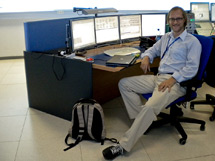
Handy Links
SLAC News Center
SLAC Today
- Subscribe
- Archives: Feb 2006-May 20, 2011
- Archives: May 23, 2011 and later
- Submit Feedback or Story Ideas
- About SLAC Today
SLAC News
Lab News
- Interactions
- Lightsources.org
- ILC NewsLine
- Int'l Science Grid This Week
- Fermilab Today
- Berkeley Lab News
- @brookhaven TODAY
- DOE Pulse
- CERN Courier
- DESY inForm
- US / LHC
SLAC Links
- Emergency
- Safety
- Policy Repository
- Site Entry Form

- Site Maps
- M & O Review
- Computing Status & Calendar
- SLAC Colloquium
- SLACspeak
- SLACspace
- SLAC Logo
- Café Menu
- Flea Market
- Web E-mail
- Marguerite Shuttle
- Discount Commuter Passes
-
Award Reporting Form
- SPIRES
- SciDoc
- Activity Groups
- Library
Stanford
Around the Bay
People: Paul Jackson, Blogging a Physicist's Life
SLAC physicist Paul Jackson works at CERN on the Large Hadron Collider's ATLAS detector. In his free time, he runs marathons, hikes the European countryside and travels around the world to attend conferences. He's also the lead singer for an all-ATLAS band. The name of the band? AWESOME [sic].
It all makes life as a particle physicist sound pretty sweet.
Jackson is also a regular contributor to Quantum Diaries, a blog where scientists from around the world share their experiences in high energy physics. His goal in the work isn't to write about physics per se, but instead to write about what it's like being a physicist.
"A lot of people have an interest in physics these days, but don't really understand what it means to be a physicist," Jackson said. "So rather than just filling people in on the work I've been doing each week, I've been trying to give them an idea of the physics lifestyle."
Jackson has been doing high energy physics for a while. He started working with the BaBar collaboration as a graduate student at the University of Victoria, staying on through postdoctoral fellowships at Ohio State University and the University of Rome. As a member of SLAC's CERN contingent, he spends his time crafting analyses for exotic particles and fine-tuning components of the ATLAS detector at the border between France and Swizerland.
For Jackson, it's as close to an ideal situation as it gets.
"It's fantastic to be here while there's such a buzz about the place," he said. "It's really an interesting time. Everybody in high energy physics is converging on CERN these days, so there's always a lot going on."
The particles that Jackson is looking for are called gluinos: beyond-the-standard-model entities that some theories predict will be produced in the Large Hadron Collider's proton-proton collisions. They're a particularly tricky breed to study. Where most particles produced in high energy collisions decay almost instantaneously—producing tell-tale byproducts that physicists can use to confirm the identities of the original particles—gluinos can stick around for a while.
"Some fraction of the gluinos that are produced can actually come to rest by losing all of their energy through ionization energy loss," Jackson said. "Then, at some later time, they can decay—giving the very interesting event where you have a large deposit of energy that could, in principle, not have any correlation with the actual LHC collisions."
Jackson and his colleagues are working to develop the analysis tools needed to distinguish stopped gluino signals from the morass of data that will be produced in LHC collisions when the machine starts up later this year. But because the delayed decay of stopped gluinos is such a novel event, the team has to do a lot of work from scratch.
"It's very different from the types of physics most people are doing," Jackson said. "It would be a really striking signature in new physics if we found something like this."
Jackson is not only refining the analysis tools used to examine the data, he is also working to help improve the data collection tools themselves. He spends half of his time at CERN working on the ATLAS pixel detector—the array of silicon wafers that lines the inside of ATLAS, recording the presence of subatomic particles much in the way that the sensor on a digital camera records the presence of photons. Jackson works with his colleagues to help improve the software that will allow physicists to interact with the detector, and takes shifts in the ATLAS control room to see how the pixel detector responds to incoming cosmic radiation.
"In the coming weeks and months the most important thing is probably getting the detector ready for the beam when it comes in November," Jackson said. "It's all in order to improve the quality of data that we get out in the end."
So while the world waits for the restart of the LHC later this fall, Jackson will continue his work making preparations for the first round of data analysis. It will be a busy time for sure—after all, aside from all the physics, ski season is coming up and AWESOME will be hard at work preparing a track for an all-ATLAS compilation to be released early next year.
—Nicholas Bock
SLAC Today, September 9, 2009
